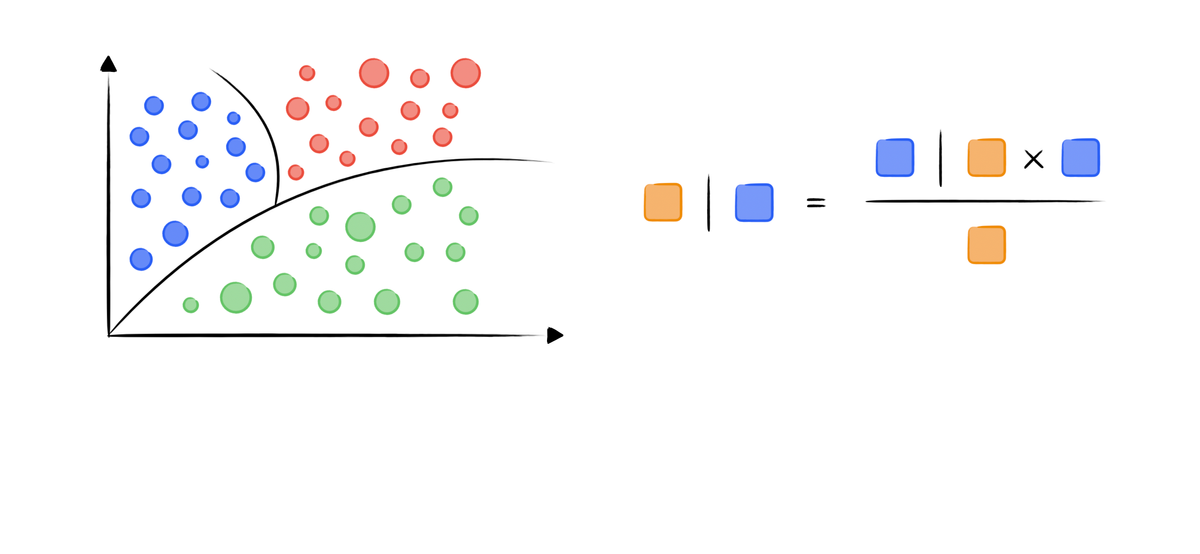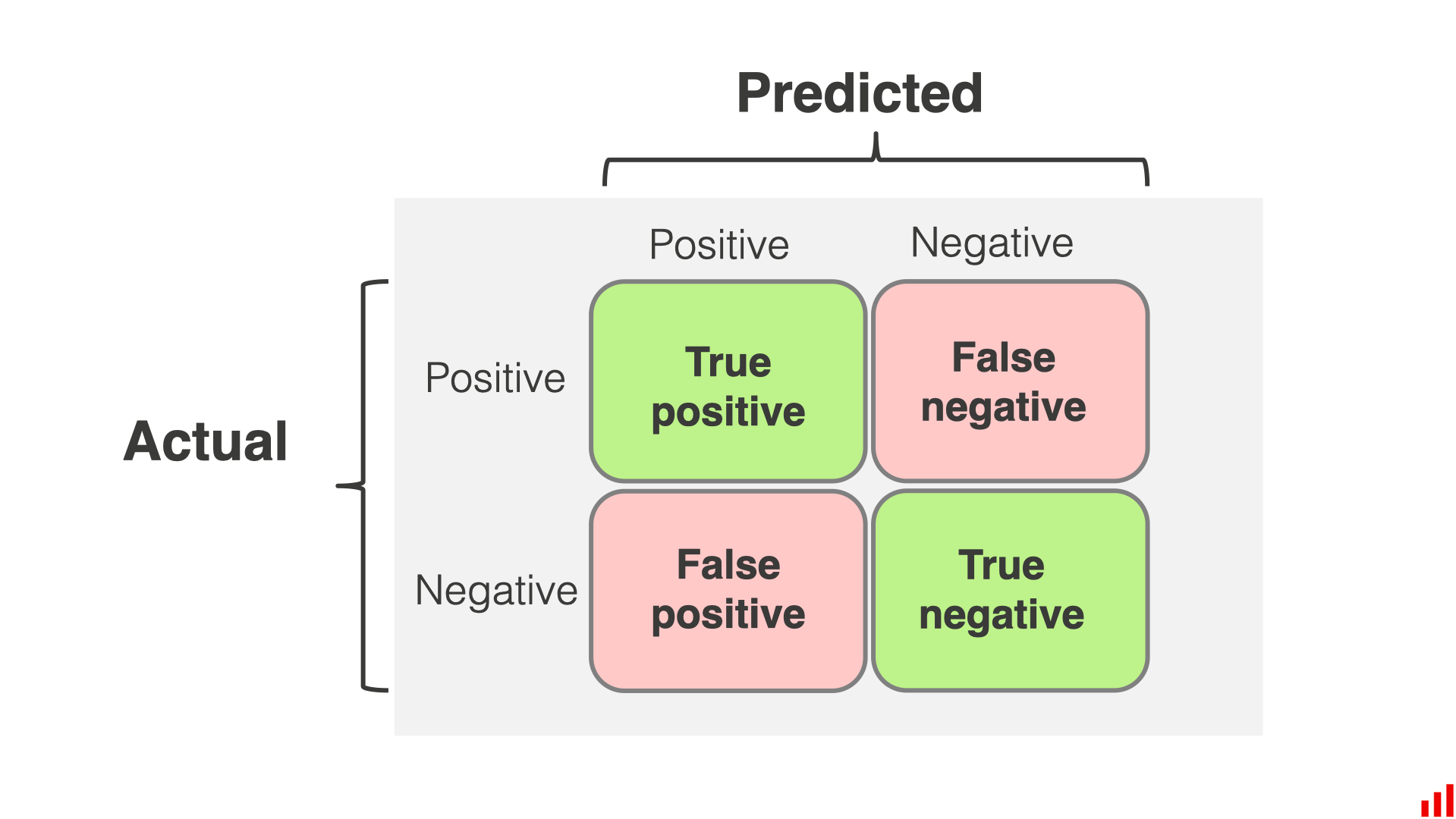Understanding Naïve Bayes Algorithm: Play with Probabilities
Naïve Bayes is a classical machine learning algorithm. By reading this post, you will understand this algorithm and implement a Naïve Bayes classifier for classifying the target customer of an ad. by the features of the customer.

Naïve Bayes Algorithm, mainly refers Multinomial Naïve Bayes Classifier, is a machine learning algorithm for classification. It mathematically based on the Bayes Theorem:
$$P(\text{class}|\text{feature}) = \frac{P(\text{feature}|\text{class})P(\text{class})}{P(\text{feature})}$$
It is easy to prove based on some prior knowledge on Joint probability
$$P(A\cap B)=P(A|B) \cdot P(B)$$
$$P(A\cap B)=P(B|A) \cdot P(A)$$
Hence, we can connect these two formula via $P(A\cap B)$
$$P(A|B) \cdot P(B) = P(B|A) \cdot P(A)$$
Divide both side with $P(B)$,
$$P(A|B) = \frac{P(B|A) \cdot P(A)}{P(B)}$$
Bayes Theorem
Here is an exercise on Wikipedia: Drug testing

Suppose, a particular test for whether someone has been using cannabis is 90% sensitive, meaning the true positive rate (TPR) = 0.90. Therefore, it leads to 90% true positive results (correct identification of drug use) for cannabis users.
The test is also 80% specific, meaning true negative rate (TNR) = 0.80. Therefore, the test correctly identifies 80% of non-use for non-users, but also generates 20% false positives, or false positive rate (FPR) = 0.20, for non-users.
Assuming 0.05 prevalence, meaning 5% of people use cannabis, what is the probability that a random person who tests positive is really a cannabis user?
$$P(pred_T|real_T) = 0.9$$
$$P(pred_T|real_F) = 0.2$$
$$P(real_T) = 0.05$$
find $P(real_T|pred_T) = ?$
$$P(real_T|pred_T) = \frac{P(pred_T|real_T)P(real_T)}{P(pred_T)}$$
$$P(pred_T)=P(pred_T|real_T)*P(real_T)+P(pred_T|real_F)*P(real_F)$$
$$=\frac{0.9*0.05}{0.05*0.9+0.95*0.2}=0.1914893617$$
Classes and Features
The idea here is to find a class (or say classify) of given features, where class refers to prediction result and features refers all attributes for a specific $X$.
Note that we let $X_i$ be monthly income, martial status of a person, or frequencies of some words in an email, or number of bedrooms, size, distance from subway of a house (which could determine its renting price).
Besides, we could let $y$ be a result corresponding to these $X_i$'s, such as monthly income, martial status of a person may infer the willingness of purchasing by an advertisement, frequencies of some words (free, refund, paid, special) could infer the spam email.
Priors
Since we have figured out the $X$ (feature) and $y$ (class), it is clear that we have frequencies of $X$ and $y$ from statistics. Mathematically, they are $P(\text{feature}_i) = \frac{n(\text{feature}_i)}{n(\text{all})} $ and $P(\text{class}) = \frac{n(\text{class})}{n(\text{all})}$. These kind of probabilities are called priors.
According to the Bayes Theorem which mentioned before:
$$P(\text{class}|\text{feature}) = \frac{P(\text{feature}|\text{class})P(\text{class})}{P(\text{feature})}$$
The bridge connects $P(\text{class}|\text{feature})$ and priors are $P(\text{feature}|\text{class})$. But what are they?
Conditional Probability
In Statistics $P(A|B)$ is conditional probability. $P(A|B)$ is the probability of event $A$ given that event $B$ has occurred. For example, let event B as earthquake, and event A as tsunami. $P(\text{tsunami}|\text{earthquake})$ means when an earthquake happens, the probability of happening a tsunami at the same time. Out of common sense, $P(\text{tsunami}|\text{earthquake})$ is lower when the location of earthquake is far from a coast.
Back to the feature-class, $P(\text{class}|\text{feature})$ and $P(\text{feature}|\text{class})$ refer to two different condition, obviously. Let us make the feature-class be:
$A=P(\text{is spam}|\text{free, refund, paid, special})$ means when a email contains these words: free, refund, paid, special; the probability of it is a spam.
$B=P(\text{free, refund, paid, special}|\text{is spam})$ means when a email is spam (we have already know that), the probability of it containing these words: free, refund, paid, special.
Posteriors
From the previous A and B, we know that B can be easily calculated from given data (in machine learning, we always have some lines of data as input of algorithms), which is "empirical".
While A refers the probability of the email is a spam if given data contains free, refund, paid, special. When the system read an email, and get the vocabulary frequency, it could have these situations:
free contains | not contains
refund contains | not contains
paid contains | not contains
special contains | not containsThere could be $2^4$ possible combinations of the 4 words. For all emails, they must meet one of the combinations of these words. Hence, we can get a True-False attributes set for the 4 words.
For example, (True, True, True, False) indicates that email contains "free", "refund", "paid" but not contains "special". Then we can get two possibilities.
$$C = P(\text{is spam}|\text{free, refund, paid, not special})$$
$$D = P(\text{is not spam}|\text{free, refund, paid, not special})$$
The task, to find out if the email contains free, refund, paid, but not contains special is a spam, could be converted into find $\max(C, D)$. If C is larger, the email is higher likely to be a spam. Then the classifier could tell the probability of the email contains free, refund, paid, but not contains special is a spam (such as 75%).
Integration
The class-feature $P(\text{class}|\text{feature})$ works as classifier, and it is calculated by Bayes Theorem:
$$P(\text{class}|\text{feature}) = \frac{P(\text{feature}|\text{class})P(\text{class})}{P(\text{feature})}$$
The training process could be mathematically converted into calculation by the given formula.
With the aid of following formulas
$$P(\text{f}|\text{c}) = P(\text{f}_1|\text{c}) \times P(\text{f}_2|\text{c}) \times ... \times P(\text{f}_n|\text{c})$$
$$P(\text{f}) = P(\text{f}_1) \times P(\text{f}_2) \times ... \times P(\text{f}_n)$$
We could cumprod each probabilities and get the posteriors easily.
Implementation
The code implements a Naïve Bayes classifier for finding out if a user will purchase from the advertisement from given features: gender, age, estimation salary.
The data could be downloaded from: https://raw.githubusercontent.com/Ex10si0n/machine-learning/main/naive-bayes/data.csv
wget https://raw.githubusercontent.com/Ex10si0n/machine-learning/main/naive-bayes/data.csvData Preprocessing
The provided code reads data from a CSV file, separates the headers and data, splits it into training and testing sets, and further splits them into features and labels.
Calculate all of the conditional probabilities
Calculate all of the priors
Applying the Bayes Theorem
Result
View full code here:
Conclusion
Naïve Bayes is a fast and simple algorithm that requires a little training data, making it suitable for large datasets or data with limited labeled examples. It also has the advantage of being able to handle multiple classes, making it a popular choice for text classification and spam filtering.
In conclusion, Naïve Bayes is a simple yet powerful algorithm that is widely used in many real-world applications. Despite its "naïve" assumption of independent features, it has proven to be a reliable method for classification in many scenarios.

